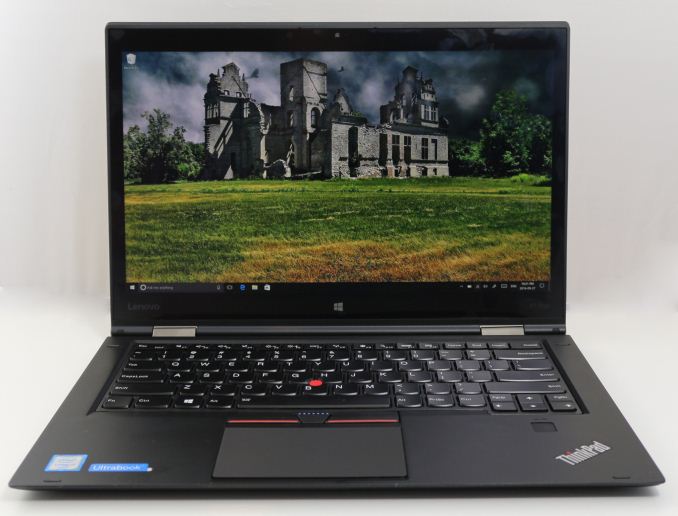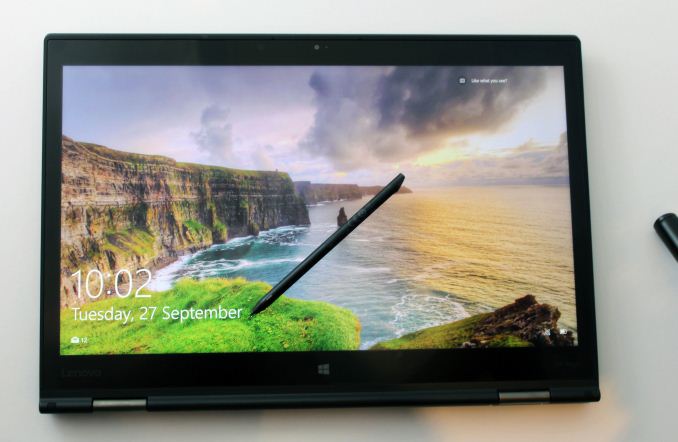The Lenovo ThinkPad X1 Yoga Review: OLED and LCD Tested
by Brett Howse & Brandon Chester on September 29, 2016 11:30 AM EST
Earlier this year at CES, Lenovo took the wraps off their latest lineup of premium business class notebooks, and they revamped the X1 lineup completely. Originally the X1 was just the X1 Carbon notebook, but Lenovo has decided to expand the X1 series to include the aforementioned X1 Carbon, along with the X1 Yoga and X1 Tablet. So the ThinkPad Yoga is now the ThinkPad X1 Yoga, and as such it keeps the same thin and light design of the X1 Carbon.
The Lenovo ThinkPad X1 Yoga Review
Thin and light is the key here, and the X1 Yoga doesn’t disappoint. The X1 Yoga is only 16.8 mm (0.66”) thick, and weighs 1270 grams (2.8 lbs). While not the thinnest and lightest notebook around, don’t forget that the X1 Yoga also features a 360° hinge, allowing it to be used exclusively with touch with several modes, including tablet, stand, and tent, just like the other Yoga devices they sell. Lenovo also pointed out that the X1 Yoga is thinner and lighter than the original X1 Carbon even, despite including touch and the convertible hinges.
Lenovo is offering plenty of choices here to outfit the X1 Yoga, with the baseline offering of an Intel Core i5-6200U and 8 GB of LPDDR3-1866. You can upgrade to the i5-6300U, i7-6500U, and i7-6600U, with RAM offerings up to 16 GB. On storage Lenovo has gone all NVMe, with choices from 128 GB to 512 GB. On the display side, the 14-inch panel can be either a 1920x1080 IPS, 2560x1440 IPS, or a 2560x1440 OLED model.
| Lenovo ThinkPad X1 Yoga | |||||
| As Tested: Core i7-6500U, 8GB, 512GB, 2560x1440 LCD | |||||
| CPU | Intel Core i5-6200U Dual-Core with Hyperthreading 2.3-2.8 GHz, 3MB Cache, 15W TDP Intel Core i5-6300U Dual-Core with Hyperthreading 2.4-3.0 GHz, 3MB Cache, 15W TDP Intel Core i7-6500U Dual-Core with Hyperthreading 2.5-3.1 GHz, 4MB Cache, 15W TDP Intel Core i7-6600U Dual-Core with Hyperthreading 2.6-3.4 GHz, 4MB Cache, 15W TDP |
||||
| GPU | Intel HD 520 300-1050MHz, 24 EUs |
||||
| Memory | 8GB to 16GB LPDDR3-1866 Dual-channel | ||||
| Display | 14-inch 1920x1080 IPS Optional 2560x1440 IPS Optional 2560x1440 OLED |
||||
| Storage | 128GB to 1TB SSD, PCIe and SATA | ||||
| I/O | OneLink+ USB 3.0 Type-A x 3 Headset jack 720p Webcam Mini DisplayPort microSD |
||||
| Dimensions | 333 x 229 x 16.8 mm 13.11 x 9.01 x 0.66 inches |
||||
| Weight | 1.27 kg / 2.8 lbs | ||||
| Battery | 52 Wh, 65 W AC Adapter | ||||
| Keyboard | Spill-Resistant with TrackPoint | ||||
| Wireless | Intel Dual Band Wireless-AC8260 2x2:2 with Bluetooth 4.1 |
||||
| Price | Starting at $1400, as tested $1871.10 | ||||
Lenovo also offers plenty of connectivity on the X1 Yoga, including three USB 3.0 ports, HDMI, DisplayPort, and a OneLink connector for its docking stations. There are no USB Type-C ports, but the X1 Yoga does have MicroSD support for additional storage, and LTE-A as an option for those that want to be as untethered as possible. Wireless is supplied via the Intel 8260 wireless card, and as a business focused device it can be had with vPro as well.
They also include a stylus built into the laptop which will charge while docked. It’s not as big or as comfortable as the one included with something like the Surface Book, but the fact that it is docked will more than make up for that for a lot of people, because that means it’s always available, and less likely to get misplaced.
Lenovo has gone with a 52 Wh battery for this laptop, meaning it is over the 50 Wh baseline for Ultrabooks. That’s pretty good considering the inclusion of a stylus, and the thin nature of this device.











84 Comments
View All Comments
mooninite - Thursday, September 29, 2016 - link
$1800 and no Iris graphics? I'll pass.ddriver - Thursday, September 29, 2016 - link
Knock yourself out.JoeyJoJo123 - Thursday, September 29, 2016 - link
After you, ma'am.ddriver - Thursday, September 29, 2016 - link
U his boyfriend?The device scores in the top of its class as it is. Iris graphics won't make it more useful in its intended usage context, only more expensive. But I guess the important part here is that your boyfriend won't be buying a device cuz it didn't have a component that makes no sense having. Good to know.
JoeyJoJo123 - Thursday, September 29, 2016 - link
Another *simply epic* post by ddriver!forgot2yield28 - Friday, September 30, 2016 - link
You're joking, right? I run procurement for an architecture office. I wouldn't order this over an XPS 13 because you can get the XPS with Iris. They're not the workhorse of our office, but for getting some work done on an airplane and giving a presentation while manipulating CAD drawings, something with Iris or discrete graphics is critical. I can appreciate that the niche for professional ultrabook users who demand higher graphics performance is small, but to say that it wouldn't make the product more useful to professionals is simply shortsighted.close - Friday, September 30, 2016 - link
ddriver is usually here for two purposes:-some pseudo-engineering rants that are laughable until you realize he might actually believe them (then it feels like you're laughing at an autistic kid).
-make some sort of homophobic remark, or any kind of insult really. The kind that suggests he was raised and educated by 4chan.
ddriver - Friday, September 30, 2016 - link
I am glad you finally found a purpose in life. As pathetic as it may be, that's a huge step up for you LOL, your peak lifetime achievement really.ddriver - Friday, September 30, 2016 - link
You are joking, right? This is a convertible device that can be used as a tablet and comes with a stylus while the xps 13 is an ultrabook without tablet mode or stylus support. Which explains why the xps in a matching configuration is 100$ cheaper.If you are a professional and need to work with CAD you don't get a "business class" generic ultrabook, you get a laptop with dedicated professional graphics, or the very least, something with a decent discrete graphics, like the xps 15
Iris critical for CAD - that's laughable to say the least. But wait, since you did say "drawings" I can only assume you mean 2D in autocad, which, and I hate to break it to you, will show exactly ZERO advantage for iris over the plain integrated graphics. It will be marginally better for 3D, but nowhere near the 960m in the xps 15, which also has a bigger display at the same price point. Or maybe now you are also going to tell me that a smaller screen is also critical to working with cad and making presentations?
LordOfTheBoired - Friday, September 30, 2016 - link
*doesn't know CAD workload or terminology**is qualified to dictate CAD hardware demands*